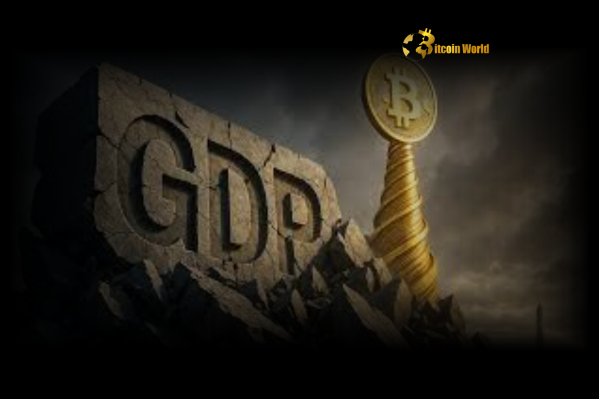BitcoinWorld

Urgent: U.S. GDP Contraction in Q1 2025 Misses Forecasts – What It Means for Your Portfolio
The financial world is abuzz with the latest revelation: the U.S. economy has hit a snag. In a surprising turn of events, the U.S. GDP contracted by 0.5% in the first quarter of 2025, a stark deviation from the anticipated 0.2% decline. This crucial economic indicator, meticulously tracked by the U.S. Bureau of Economic Analysis, serves as a vital barometer for the nation’s financial health. For investors, particularly those navigating the volatile cryptocurrency markets, understanding this economic contraction is paramount. It’s not just a number; it’s a signal that could reshape investment strategies and market sentiment as we move deeper into Q1 2025 and beyond.
Understanding the Startling U.S. GDP Contraction in Q1 2025
Gross Domestic Product (GDP) represents the total monetary value of all finished goods and services produced within a country’s borders in a specific time period. It’s the broadest measure of economic activity. The recent data, which revealed a 0.5% decline in the U.S. GDP for Q1 2025, marks a significant reversal from the robust 2.4% expansion observed in the previous quarter. This final estimate confirms a cooling, if not outright shrinking, of economic activity.
To put this into perspective, consider the recent trajectory:
| Quarter | U.S. GDP Growth (Annualized Rate) | Market Expectations |
|---|---|---|
| Q4 2024 | +2.4% (Expansion) | Met/Exceeded |
| Q1 2025 | -0.5% (Contraction) | -0.2% (Missed) |
This negative shift indicates that the American economy produced fewer goods and services than it did in the preceding three months, signaling a slowdown that could have far-reaching implications for businesses, consumers, and global markets.
Why Did the Economy Miss Market Expectations So Significantly?
The fact that the U.S. GDP contracted more than analysts had predicted is a key point of concern. Market expectations are typically based on a myriad of economic indicators, forecasts, and sentiment analyses. When the actual figures diverge so sharply, it suggests underlying weaknesses that may have been underestimated. Several factors likely contributed to this steeper-than-expected decline:
- Slowing Consumer Spending: As the backbone of the U.S. economy, a deceleration in consumer purchases of goods and services can significantly drag down GDP. Factors like persistent inflation, higher interest rates, and waning consumer confidence could be at play.
- Reduced Business Investment: Companies might be scaling back on investments in new equipment, software, and structures due to uncertainty about future demand, higher borrowing costs, or supply chain disruptions.
- Government Spending Adjustments: Changes in federal, state, and local government expenditures can also impact GDP. A reduction in government projects or aid could contribute to a slowdown.
- Net Exports Fluctuation: The balance between exports and imports plays a role. If imports significantly outpace exports, it creates a drag on GDP. Global economic slowdowns can impact demand for U.S. goods.
- Inventory Adjustments: Businesses might be reducing their inventories, which can temporarily reduce GDP even if final sales remain stable.
The confluence of these elements created a perfect storm, leading to an economic contraction that caught many off guard, forcing a re-evaluation of the immediate economic outlook.
The Ripple Effect: How This Economic Contraction Impacts Various Sectors
A significant economic contraction like the one seen in Q1 2025 doesn’t happen in a vacuum. Its effects reverberate across different sectors of the economy, creating both challenges and, potentially, unexpected opportunities. Understanding these impacts is crucial for making informed decisions.
Impact on Traditional Markets:
- Stocks: Typically, a contracting economy signals lower corporate profits, which can lead to stock market declines. Defensive sectors (utilities, consumer staples) might fare better than cyclical ones (technology, consumer discretionary).
- Bonds: In times of economic uncertainty, investors often flock to safe-haven assets like government bonds, driving up their prices and pushing down yields.
- Interest Rates: A weaker economy might prompt the Federal Reserve to consider pausing or even cutting interest rates to stimulate growth, though this depends heavily on inflation figures.
Implications for the Cryptocurrency Market:
The cryptocurrency market, while often seen as distinct, is not entirely immune to macroeconomic shifts. A significant U.S. GDP contraction can influence crypto in several ways:
- Risk-Off Sentiment: In times of economic uncertainty, investors tend to reduce exposure to higher-risk assets, which often includes cryptocurrencies. This can lead to selling pressure and price declines.
- Dollar Strength: A weaker U.S. economy might lead to a stronger U.S. dollar if global investors seek safety in the world’s reserve currency, potentially impacting crypto prices denominated in USD.
- Inflationary Pressures vs. Deflationary Concerns: If the GDP contraction signals potential deflation (falling prices), it could challenge the “inflation hedge” narrative often associated with Bitcoin. However, if central banks respond with more quantitative easing, it could reinforce the demand for scarce digital assets.
- Innovation and Adoption: Despite short-term price volatility, a challenging economic environment can sometimes accelerate innovation and the search for alternative financial systems, potentially benefiting the long-term adoption of decentralized technologies.
Navigating the Uncertain Economic Outlook: Strategies for Investors
Given the confirmed economic contraction in Q1 2025 and the uncertain economic outlook, what steps can investors take to protect and potentially grow their portfolios? While no advice guarantees returns, certain strategies can help mitigate risks and position you for future recovery.
Actionable Insights:
- Diversify Your Portfolio: Don’t put all your eggs in one basket. Spread your investments across different asset classes (stocks, bonds, real estate, commodities, and a carefully considered portion in cryptocurrencies). Within crypto, consider a mix of established assets like Bitcoin and Ethereum, alongside promising altcoins.
- Reassess Risk Tolerance: A contracting economy often means higher volatility. Re-evaluate your personal risk tolerance and adjust your portfolio accordingly. This might mean reducing exposure to highly speculative assets.
- Focus on Quality and Fundamentals: For stocks, look for companies with strong balance sheets, consistent earnings, and resilient business models. In crypto, prioritize projects with clear utility, robust technology, and strong development teams rather than hype-driven ventures.
- Dollar-Cost Averaging (DCA): Instead of trying to time the market, invest a fixed amount regularly. This strategy helps average out your purchase price over time, reducing the impact of market volatility, especially during a downturn.
- Stay Informed and Patient: Economic cycles are natural. While the current contraction is concerning, markets eventually recover. Stay updated on economic data, central bank policies, and global events, but avoid impulsive decisions based on short-term news.
- Consider Safe Havens: While traditional safe havens like gold and certain bonds might be appealing, some argue that Bitcoin, due to its decentralized and finite nature, could eventually act as a digital safe haven, though its volatility remains a factor.
The key is to remain disciplined and avoid panic. Economic shifts, while challenging, often present unique opportunities for those prepared to act strategically.
Beyond Q1 2025: What Lies Ahead for the U.S. Economy?
The U.S. GDP data for Q1 2025 provides a snapshot, but the future remains fluid. Will this contraction be a one-off blip, or does it signal the onset of a more prolonged downturn or even a recession? The answer hinges on several factors that will unfold in the coming quarters.
Key Factors to Watch:
- Inflation Trends: The Federal Reserve’s response will largely depend on whether inflation continues to be a concern. If inflation cools, the Fed might have more room to ease monetary policy, which could support economic recovery.
- Labor Market Strength: A resilient job market can cushion the blow of economic slowdowns, maintaining consumer spending power. Any significant weakening here would be a major red flag.
- Global Economic Health: The performance of major trading partners and global supply chains will also influence the U.S. economy. A synchronized global slowdown could exacerbate domestic issues.
- Policy Responses: Government fiscal policies (e.g., spending packages, tax changes) and the Federal Reserve’s monetary policy decisions will play a critical role in shaping the recovery trajectory.
While the immediate economic outlook is clouded by the recent contraction, economies are dynamic. Businesses adapt, consumers adjust, and policymakers intervene. The path forward will likely involve a delicate balancing act between controlling inflation and fostering growth. For crypto enthusiasts, this macro backdrop underscores the importance of understanding broader economic forces, as they often dictate the tides of the digital asset space.
A Compelling Summary: Navigating the Economic Shift
The 0.5% contraction in U.S. GDP for Q1 2025 is a sobering reminder that economic growth is not guaranteed. This unexpected downturn, missing market expectations, highlights the fragility of the current recovery phase and introduces significant uncertainty into the economic outlook. From traditional stock markets to the dynamic world of cryptocurrencies, the ripple effects of this economic contraction will be felt across various investment landscapes.
However, challenging times also foster resilience and innovation. For investors, this period calls for prudence, strategic diversification, and a deep understanding of market fundamentals. By staying informed and adopting a long-term perspective, you can navigate these economic shifts and position yourself for future opportunities. The coming quarters will be critical in determining whether this is a temporary setback or a harbinger of deeper economic challenges, making vigilant observation more important than ever.
To learn more about the latest economic trends and their impact on the crypto market, explore our articles on key developments shaping Bitcoin and Ethereum price action.
This post Urgent: U.S. GDP Contraction in Q1 2025 Misses Forecasts – What It Means for Your Portfolio first appeared on BitcoinWorld and is written by Editorial Team





